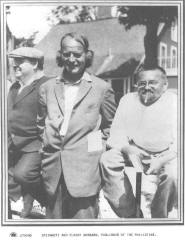| Rotary
Founder Paul Harris quote Steinmetz in discussion the power of
Rotary
for world peace.
"No man
really becomes a fool until he stops asking questions." - Charles
Proteus Steinmetz
 Charles
Proteus Steinmetz was a giant of a pioneer in the field of
electrical engineering, who invented a commercially successful
alternating current motor. Only four feet tall in real life, his
middle name Proteus, was named after the Greek god who could take on any
shape or size. Charles
Proteus Steinmetz was a giant of a pioneer in the field of
electrical engineering, who invented a commercially successful
alternating current motor. Only four feet tall in real life, his
middle name Proteus, was named after the Greek god who could take on any
shape or size.
Charles Steinmetz was born in Breslau,
Prussia on April 9, 1865. Breslau is now the city Wroclaw, Poland. He
studied in Breslau, Zurich and Berlin. Shortly after receiving his Ph.D.
in 1888, Steinmetz was forced to flee Germany after writing a paper
critizing the German government. Charles Steinmetz was an active
socialist and held strong anti-racist beliefs. He immigrated to the
United States in 1893 and was hired by the General Electric Company in
Schenectady, New York. |
After
studying alternating current for a number of years, Charles Steinmetz
patented a "system of distribution by alternating current" (A/C power),
on January 29, 1895.
 Steinmetz retired as an engineer from
General Electric to teach electrical engineering at that city's Union
College in 1902. General Electric later called back as a consultant. He
had worked on a very complex system that was broken. No one could fix it
no matter how hard the technicians tried. So they got Steinmetz back. He
traced the systems and found the malfunctioning part and marked it with
a piece of chalk Steinmetz retired as an engineer from
General Electric to teach electrical engineering at that city's Union
College in 1902. General Electric later called back as a consultant. He
had worked on a very complex system that was broken. No one could fix it
no matter how hard the technicians tried. So they got Steinmetz back. He
traced the systems and found the malfunctioning part and marked it with
a piece of chalk
Charles Steinmetz submitted a bill for
$10,000 dollars. The General Electric managers were taken back and asked
for an itemized invoice.
He sent back the following invoice:
- Making the chalk mark $1
- Knowing where to place the chalk
mark $9,999
Charles Steinmetz died on October 26,
1923 and at the time of his death, held over 200 patents.
Read what Harris Quoted of Steinmetz |

